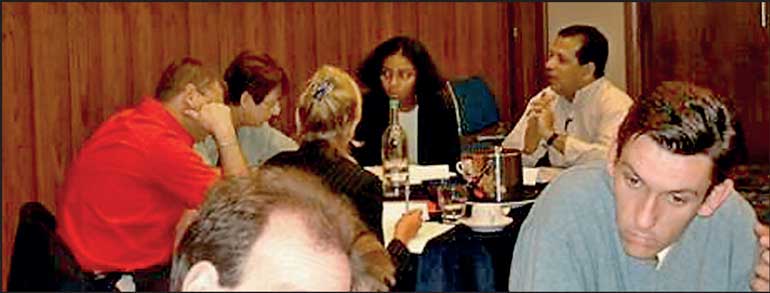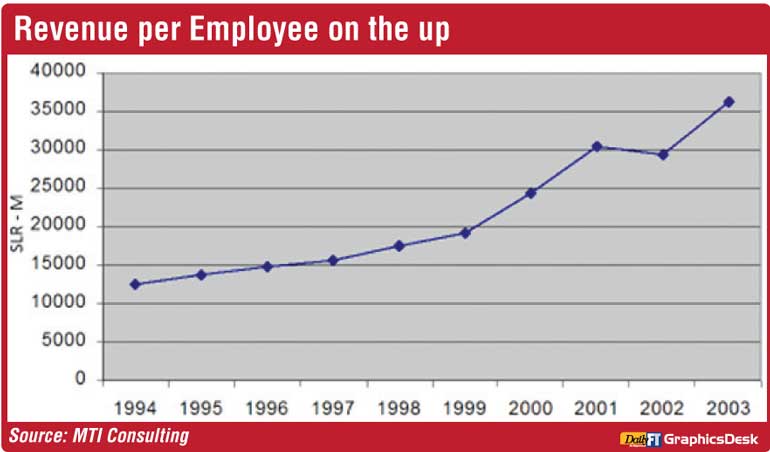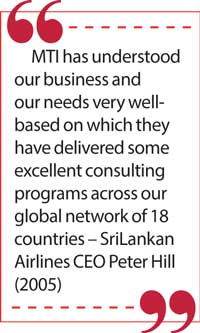Monday Apr 07, 2025
Monday Apr 07, 2025
Monday, 23 October 2023 00:18 - - {{hitsCtrl.values.hits}}

Ground-level insights from 18 countries across Europe, Asia and Middle East

Over 4,000 employees took part at the launch event at the Katunayake Hanger and at the same time in 18 countries

SriLankan Airlines CEO Peter Hill and MTI CEO Hilmy Cader in 2005, with MTI’s 8S based Strategic Planscape that was deployed as the basis of monitoring the implementation progress



If you think the current business environment for SriLankan Airlines is tough, you should re-visit 2001. In July that year, the Katunayake airport was bombed, in September 9/11 happened, dealing a double blow to the island nation’s aviation and tourism industry. It could not get any worse for an airline, but under Emirates management the airline did turnaround.
Based on the Strategic Planning work done by MTI Consulting for SriLankan, the case study of the airline’s turnaround was publicly presented in 2005. MTI Consulting looks back on a similar turbulent period in the airline’s recent history – in which the national carrier ‘weathered the storm and headed into clear skies’.
The airline’s bottom-line was ‘in the red’ following successive years of massive losses; a loss of Rs. 750 million in 2000 and Rs. 6.5 billion in 2001. The airline had also lost half its fleet as a result of a terrorist attack at the Katunayake Airport in 2001 and the global airline industry was in the doldrums following the 9/11 terror attacks in USA.
Adding to these woes, the airline was also facing a number of internal challenges. These included flying to unprofitable routes, unsuitable aircraft mix, low yields and low selling prices – as well lack of focus on product development, brand management and emerging channels.
In this environment, the Strategic Planning Exercise was initiated with the short-term intention of improving profitability of the airline (to $ 48 million by 2005) and the long-term intention of being the most preferred airline in Asia.
Ground-level insights from 18 countries across Europe, Asia and Middle East
 The rigorous process which followed a ‘ground-zero’ approach, questioning even the basis of the airline to exist, obtained significant buy-in of the senior management (including the airline’s CEO at the time, Peter Hill) and was intensively bottom-line focused. The strategic process featured ConsuLearning Workshops, use of cross-functional teams, facilitation of self-realisation, tapping into the own insights and innovations of the SriLankan Airlines team and cross-industry/cross-border learnings.
The rigorous process which followed a ‘ground-zero’ approach, questioning even the basis of the airline to exist, obtained significant buy-in of the senior management (including the airline’s CEO at the time, Peter Hill) and was intensively bottom-line focused. The strategic process featured ConsuLearning Workshops, use of cross-functional teams, facilitation of self-realisation, tapping into the own insights and innovations of the SriLankan Airlines team and cross-industry/cross-border learnings.
Following a systematic process, the business focus required to reach the airline’s target level of profitability were narrowed down to seven core strategies: corporate brand equity (based on a new world-class product), profitable selling, network/route/frequency rationalisation, improving business class product, reservations systems efficiency (IT investment), service quality and consistent delivery and cost optimisation.
To enable/facilitate the execution of the strategic plan developed via the exercise, the strategies were broken down into business health indicators for effective measurement – which were linked to an automated performance management system. Ten project champions and teams were also appointed to facilitate execution.
The Strategic Planning Exercise concluded with the launch of SriLankan’s new mission, vision and values (the development of which were facilitated via the exercise) – with 4,200 employees taking part in the launch event, making it one of the largest-ever events of its calibre held in Sri Lanka.
Results
Revenue per employee grew to Rs. 9 million in 2003, a nearly three-fold increase from 1998/99 levels. Significant change in the attitudes of the staff was also observed, thereby boosting service standards and the organisational culture underwent a drastic transformation.
Reflecting independent recognition of the turnaround in performance, the airline clinched the Centre for Asia Pacific Aviation Award for ‘Airline Turnaround of the year 2004’ as well as numerous others. These included the award for the Skytrax Best Airline in Central Asia in 2001, 2002, 2003 and 2004, Skytrax World’s Friendliest Cabin Crew 2002 and TTG (Asia) Best Airline in South Asia 2002.
The learnings from the previous Strategic Planning Exercise of SriLankan Airlines is particularly relevant at present, considering that the airline was the country’s third-largest loss-making State-Owned Enterprise (SOE) from 2006 to 2015 (according to Advocata Institute’s report – The State of State Enterprises in Sri Lanka).
These losses accounted for over a fifth of the total losses of the country’s SOEs (categorized as strategically important by the treasury) from 2006 to 2015, based on the Advocata report.
During this period (2006 to 2015) the airline made a cumulative loss of Rs. 128 billion (based on the report). Put in context, this loss is greater than the national recurrent expenditure by the Sri Lankan Government on health in 2014 was (which only amounted to Rs. 116.2 billion as per the 2015 Annual Report of the Central Bank of Sri Lanka).
“The Strategic Planning Exercise undertaken by SriLankan Airlines in 2001 has much significance in the present environment, for SriLankan Airlines in specific and for loss-making SOEs in the country in general,” MTI Consulting CEO Hilmy Cader points out. “At a time at which the efficiency of public enterprises have come under close scrutiny, this case study serves as an important reminder that even with largely the same staff the other resources, a SOE can achieve profitability if it follows a prudent strategic plan and if there is commitment at all levels of the organization – especially at the senior management level.”
“This also serves as a stark reminder of the dangers of abandoning the strategic planning process as well poor management – which resulted in a once profitable institution becoming one of the biggest loss-makers and hence a heavy burden to the Treasury.”
MTI Consulting is an internationally-networked, boutique management consultancy enabling its clients to ‘Analyze > Strategize > Realize’ profitable business opportunities. Practices include Strategy, Business Operations, Corporate Finance, Talent & Resourcing, Go-to-Market and Tech-Advisory. Since its inception in 1997, MTI has worked on over 520 assignments in over 43 countries, covering a diverse range of industries, clients and business challenges. Its team comprises of a multi-national pool of Strategists, Analysts, Researchers, Industry Specialists and Functional Specialists.
“MTI has understood our business and our needs very well-based on which they have delivered some excellent consulting programs across our global network of 18 countries”: Peter Hill, CEO SriLankan Airlines (2005).